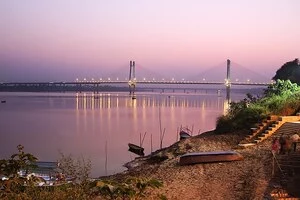History of Allahabad
Home »
 Allahabad, or Prayag, is unique for being located at the confluence of the three holy rivers, the Ganga, Saraswati and Yamuna. As one of the holiest of cities, the history of Allahabad going back thousands of years. It is worth knowing more about Allahabad.
Allahabad, or Prayag, is unique for being located at the confluence of the three holy rivers, the Ganga, Saraswati and Yamuna. As one of the holiest of cities, the history of Allahabad going back thousands of years. It is worth knowing more about Allahabad.
Origin and History of Allahabad
The area dates back to ancient times as evidenced excavations relating it to the Iron Age. The Puranas mention Prayag as being the seat of Yayati who founded the four main tribes of the Rigveda through his five sons. The Aryans are believed to have settled here at a time when it was ruled by the Kurus. The Prayag became the origin of Hinduism. The Kurus split into two clans, one being the Kurus and the other being the Vatsas. Vatsas controlled the upper and lower portions; with the latter being split into further two groups. Prayag finds mention in the Ramayana stating that the Lord spent some time at the ashram of Bharadwaja Muni.
In the later periods, Prayag came under the Gupta and Mauryan empires and then it was part of the Kannauj Empire as well as the Kushan Empire in the 1st century AD. The Turks invaded Northern India and the city became part of the Sultanate of Muhammad Ghori in 1193. The Mughals followed in 1526 and the city came under their rules. Akbar built a fort that still stands here and named the city Allahabad that changed to Allahabad as it is still known. Akbar’s son, Prince Salim led the revolt against his father here in 1602 and held court here.
As Mughal rule declined the Marathas came into power and they left their legacy here in the form of two dating back to the 18th century. The British then overcame the Nawab of Awadh and Shah Alam II in 1765 at the Battle of Buxar and they put up a garrison at the Fort. The city came into the limelight in 1857 as it became a hub of the Indian Mutiny after which the British made it the capital of the North-Western Provinces.
The place is also of importance for Buddhists. It was the seat of the Vatsa kingdom named Kosambi. And it was prosperous at the time of Gautama Buddha. The city was an important centre of trade and commerce famed worldwide even in ancient times.
Significance
For independent India, Allahabad is of importance since it was a hotbed of the Indian Mutiny in the 1857 when Maulvi Liaquat Ali brought the city under the control of the rebels. Unfortunately the British prevailed and quelled the mutiny. However, even then, Allahabad remained important as the Indian National Congress held sessions here in 1888 and 1892, making it a focal point for revolutionaries.
Chandrasekhar Azad killed himself here at Alfred Park in 1931. The Nehru family had its home here at Anand Bhawan and Swaraj Bhawan. Both of which became the centre of political activities as the momentum for independence gained pace. It is also noteworthy that Jawaharlal Nehru, the first Prime Minister of India, hailed from Allahabad. Lal Bahadur Shastri, Muzaffar Hassan, Kailash Nath Katju and Mangla Prasad were also from this city. Allahabad is also where the concept of Pakistan took birth in 1930 when Allama Muhammad Iqbal proposed a separate Muslim state.
Going back in time, Prayag, as the city was known, was an important centre of education. Allahabad University was founded in 1887. It is one of the oldest universities in India and is termed the Oxford of the East.
For Hindus, the city of Prayag is of utmost importance. It is said to be the birthplace of Prajapati, Varuna and Soma Gods. This is where the ancient Sages Durvasa, Pannas and Bharadwaja, lived about 5000 years ago and taught over 10000 disciples. This is where Brahma, the Creator offered his first sacrifice after creating the world. Prajapati conducted a huge Yagya here. Allahabad is one of the three holy pilgrimage sites, the other two being Kashi and Gaya.
Allahabad is where the Kumbh Mela is held every 12 years and bathing in the waters of the Triveni Sangam frees you of all sins. The Magh Mela is an annual pilgrimage held in the sacred Hindu month of Magh at the Triveni Sangam site. Bathing in the river during this period bestows bliss on the pilgrim.
The Rigveda states that he who sacrifices his body here attains final liberation. Padma Purana states that Prayag is the supreme of all pilgrimage places. It is believed that when the world is engulfed by floods in the future, only Prayag will not be submerged because it is protected by the Gods. Allahabad is the site of the ancient and sacred Akshayavat banyan tree. It is said to be the abode of deities with its roots extending to Patal. If one sacrifices one’s body near the Akshayavat, one attains salvation. Despite the best efforts of Jahangir to kill the tree, it kept on regenerating itself. The tree still stands inside the Akbar Fort.
Allahabad is no less important than Varanasi. The oldest inhabited living city and the Char Dham when it comes to religious significance.
Even otherwise, in today’s world, Allahabad is a flourishing city, a centre of education and commerce.
Hope you enjoyed reading the history of Allahabad!

Leave a Reply